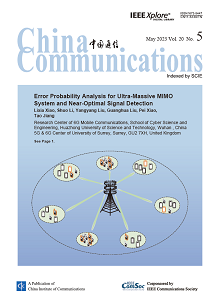
In this paper, average bit error probability (ABEP) bound of optimal maximum likelihood (ML) detector is first derived for ultra massive (UM) multiple-input-multiple-output (MIMO) system with generalized amplitude phase modulation (APM), which is confirmed by simulation results. Furthermore, a minimum residual criterion (MRC) based low-complexity near-optimal ML detector is proposed for UM-MIMO system. Specifically, we first obtain an initial estimated signal by a conventional detector, i.e., matched filter (MF), or minimum mean square error (MMSE) and so on. Furthermore, MRC based error correction mechanism (ECM) is proposed to correct the erroneous symbol encountered in the initial result. Simulation results are shown that the performance of the proposed MRC-ECM based detector is capable of approaching theoretical ABEP of ML, despite only imposing a slightly higher complexity than that of the initial detector.
The unreasonable observation arrangements in the satellite operation control center (SOCC) may result in the observation data cannot be downloaded as scheduled. Meanwhile, if the operation instructions released by the satellite telemetry tracking center (STTC) for the on-board payloads are not injected on the specific satellites in time, the corresponding satellites cannot perform the observation operations as planned. Therefore, there is an urgent need to design an integrated instruction release, and observation task planning (I-IRO-TP) scheme by efficiently collaborating the SOCC and STTC. Motivated by this fact, we design an interaction mechanism between the SOCC and the STTC, where we first formulate the I-IRO-TP problem as a constraint satisfaction problem aiming at maximizing the number of completed tasks. Furthermore, we propose an interactive imaging task planning algorithm based on the analysis of resource distribution in the STTC during the previous planning periods to preferentially select the observation arcs that not only satisfy the requirements in the observation resource allocation phase but also facilitate the arrangement of measurement and control instruction release. We conduct extensive simulations to demonstrate the effectiveness of the proposed algorithm in terms of the number of completed tasks.